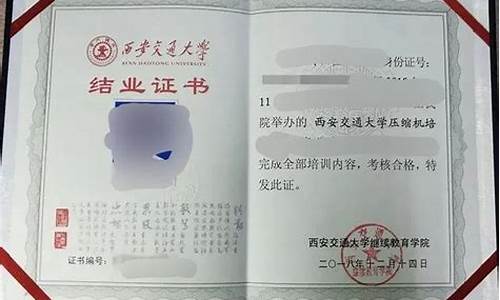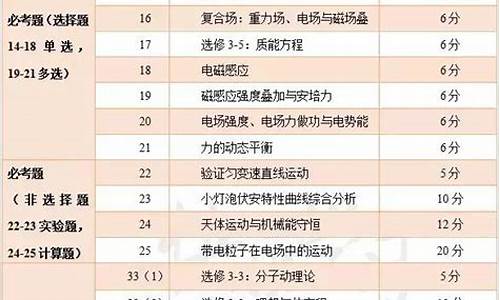您现在的位置是: 首页 > 热门专业 热门专业
倒装句高考真题汇编-倒装讲解高考
tamoadmin 2024-08-06 人已围观
简介1.能不能简单的讲讲倒装句的用法(高考英语)2.高考英语语法:2010年高考英语语法精讲三十一 倒装句3.高考倒装题一道4.高中英语语法省略句,倒装句解析.5.问一道高考英语选择题,顺便想了解一下什么是倒装.6.高考英语as 倒装能不能简单的讲讲倒装句的用法(高考英语)倒装句用法倒装句的意义和分类:英语的基本语序是“主语+谓语”。但有些场合是“谓语+主语”。这种语法现象称为倒装。整个谓语被放在主语
1.能不能简单的讲讲倒装句的用法(高考英语)
2.高考英语语法:2010年高考英语语法精讲三十一 倒装句
3.高考倒装题一道
4.高中英语语法省略句,倒装句解析.
5.问一道高考英语选择题,顺便想了解一下什么是倒装.
6.高考英语as 倒装
能不能简单的讲讲倒装句的用法(高考英语)

倒装句用法
倒装句的意义和分类:英语的基本语序是“主语+谓语”。但有些场合是“谓语+主语”。这种语法现象称为倒装。整个谓语被放在主语的前面,称为完全倒装。例如:
There goes the bell. 铃响了。
Under a big tree sat a boy reading a book.大树下坐着一个男孩在读书。
谓语的一部分(系动词、助动词或情态动词)放在主语的前面,其余的部分仍在主语之后,称为部分倒装。
例如:
Not until 10 o'clock will the library open. 直到十点种图书馆才开门。
倒装的目的:
语法结构的需要:通常疑问句、there be 结构等需要用倒装句。例如:
Was the Communist Party of China founded in 1921? 中国***是1921年成立的吗?
There stants a bridge across the river. 河上有座桥。
Where are you going? 你上哪去?
语法修饰的需要:倒装句可以起强调作用,加强语气。例如:
Still greater contributions should we make to our motherland. 我们应该对祖国作出更大的贡献。(强调宾语)
Such is the case. 情况就是这样。(强调表语)
Now comes your turn. 现在该轮到你了。(强调状语)
Up went the model plane. 那架航模飞机飞起来了。(强调状语)
倒装句结构的基本用法:
全部倒装(平衡倒装句型):
①句首是地点状语和表语时:
In front of the house sat an old man smoking a pipe. 在房屋前面坐着一位老人在抽烟斗。(句首是状语)
On wither side of the street were rows of green trees. 街道两边绿树成行。(句首是表语)
②句首有 here, there, out, in, up, down, off, away 等副词时:
Out rushed a cat from under the table. 从桌子底下窜出一只猫来。
Here is a ticket for you. 这是给你的票。
Up went the prices. 价格上涨。
③句首有 so(表肯定),neither (nor) (表否定),表示前面所说的情况也适合与另一个人或事。
He can swim. 他会游泳。
So can she. 她也会。
He did not watch TV yesterday evening. 他昨晚没看电视。
Neither did I. 我也没看。
④在there be 结构中。
There are fifty students in our class. 我班有50个学生。
⑤在某些祝愿句中。
Long live the People's Republic of China! 中华人民共和国万岁!
⑥在某些感叹句中。
How proud we are of our great motherland! 我们为伟大的祖国感到多么自豪!
部分到装(强调倒装句型)
①用于省去if 的虚拟条件句中
Were there no air or water, there would be no life in the world.如果没有水和空气,世界上就不会有生命。
②用于以as 引导的状语从句中
Rich as they are, they are not hy. 尽管他们富有,但不幸福。
③用于句首是否定意义的副词或连词时。
Seldom he I read a novel so touching as this. 我难得读到如此动人的。
Hardly did I think it possible. 我几乎认为这是不可能的。
④用于疑问句。
When did you begin to learn English? 你什么时候开始学英语的?
⑤句首是only 、后边跟状语的句子中
Only in this way can you learn English well. 只有这种方法,你才能学好英语。
⑥直接引语的全部或一部分在句首时。
"Do you think my clothes fit well?" asked the emperor.“你认为我的衣服非常合身吗?”皇帝问道。
"Mr smith" said mary,"May I borrow your pen?" “史密斯先生”玛丽说,“我可以借一下你的钢笔吗?”
⑦某些祝愿的句子(谓语带有情态动词,则为部分倒装)。
May you succeed. 祝您成功。
重难点分析
1.由疑问词或有疑问词修饰的名词作主语的特殊疑问句不倒装。如:
Who is your maths teacher? 谁是你的数学老师?(who 是主语)
Which bicycle is yours? 哪辆自行车是你的?(which 是定语,修饰bicycle )
2.在以 here, there, now, then… 等开头的句子中 here, there 强调地点但不指具体的地点,只用来引起人们的注意,要重读。同样 now, then 强调时间,也并不指具体时间,只引起人们的注意,也要重读。如:
There comes our teacher. 我们的老师来了。
在时态方面要注意,除了以 then 开头的句子用过去时外,其余均用一般现在时。如:
Then came a new problem. 那时出现了新问题。
3.主语是人称代词时不倒装。如: Here we are. 我们到了。(Here are we 错)
Away he went. 他走开了。(Away went he.错)
There he comes. 他来了。(There comes he. 错)
4.为了使句子生动、流畅,常把 in, out, down, up, away, off 等,副词放在句首,用全部倒装语序,不加助动词( do, does等)句子的动词一般都是不及物的行为动词。如:
In came the manager. 经理来了。 不说 :In did the manager come. 当主语是人称代词时,一般只把副词放在句首,不倒装。例如:
In he came and the lesson began.他进来了,于是开始上课。 不说:In came he and lesson began.
5.only 放在句首,但修饰的不是状语而是主语时,不倒装。如:
Only John is allowed to enter the lab. 只有约翰被允许进入实验室。
Only the boy himself knows what he is going to be. 只有这孩子本人知道他将来的前途。
6.以so 开头的句子。如果只是重复前面一句话的意思,不倒装。如:
It was very cold yesterday.昨天很冷。
So it was.正是这样。
He did a good job. 他干的很出色。
So he did. 确实如此。
7.以 not only 开头的句子要倒装,但but also 后面的句子不倒装。如:
Not only did he speak more correctly, but also he spoke more easily. 不仅他说得更准确,而且他说得也更轻松。
8.以 not until 开头的句子主句要倒装,没有助动词时要加助动词。如:
Not until Mother came back did it stop raining. 直到妈妈回来雨才停。
9.带有否定意义的副词和状语词组放在句首时,句子要倒装,这样的副词常见的有:no sooner…than, hardly…when, not until, never, hardly, seldom, scarecely, little, barely, at no time(=never) 等。在使用时要特别注意以hardly(barely/scarcely)…when 和 no sooner…than 开头的句子。在这种倒装句中,主句倒装从句不倒装。如:
Hardly had he got into the room when the telephone rang. 他一进屋,电话就响了。
10.频度状语如 often, seldom 等,地点状语如in front of, in the middle of 等,位于句首时,句子要倒装,没有助动词时要加助动词。如:
Seldom does it snow here.这里很少下雪。
11.充当表语的单数名词放在句首时,不加任何冠词,也不用复数形式。如:
Child as he is, he knows a lot .虽然他是个孩子,可知道的事挺多。
12.为了强调某一动作或使句子平稳和谐,将表语(形容词、现在分词、过去分词)放在句首并倒装。如:
Late as it was, he still continued learning in a poor light. 虽然天色已晚,他仍继续在微弱的光线下学习。
Late as it was表示让步,是as 的一种用法,意思相当于Though it was late 。
再举一例:
Written on the box is the model of the machine. 箱子上写了机器的型号。
这个句子的正常语序是:The model of the machine is written on the box.
written 是过去分词在句中作表语。注意本句不是被动语态,而是系表结构。
高考英语语法:2010年高考英语语法精讲三十一 倒装句
《2010年高考英语语法精讲三十一 倒装句》由留学英语组我整理(.liuxue86)。本内容整理时间为05月12日,如有任何问题请联系我们。
全部倒装
1.由here, there引起,谓语通常用 be, come, go
Look ! Here comes your sister. There goes the bell.
2. 由介词短语引起,谓语通常用be, stand, lie, live, live, sit, come, go, rise
Along the wall stand four big chairs.
At the top of the hill lay the dying soldiers.
3. 由up, down, on, in, off, away, out, back引起,谓语通常用come, go, run, rush, fly
Out rushed the boy.
Down came the rain and up went the umbrellas.
4.以上情况主语如果是代词,主谓不倒装
Here?s your watch. (Here it is.)
Up it went.
5.由个别副词引起,谓语通常是be, lie
North of the city lies (is) a railway.
6. 由such引起, 谓语通常用be
Such is what he said. Such are his words.
部分倒装
指谓语的一部分放在主语之前而引起的倒装,通常是助动词或情态动词提前或连系动词提前
1. 由never, hardly, seldom, little, not until引起
Seldom did he make any mistakes.
Not until yesterday did I receive his letter.
2. not only?but also连接两个单句时,前面的倒装
Not only was she working hard, but also she was very polite.
3. neither?nor连接两个单句时,两个句子都倒装
Neither is he studying, nor is he working.
4. no sooner?than, hardly (scarcely)?when
No sooner had we got into the room than the telephone rang.
5. 由only + 状语, so + adj. (adv.) 引起
Only then (Only at the age of 18) did he realize the importance of the problem.
6. 由as引起
Child as he is, he can work out the problem.
7. 虚拟语气的倒装
Were I you, I would work harder.
Had you come yesterday, you would he known that.
Should it rain tomorrow, you wouldn?t lee.
so (neither, nor) + be (do, he, 情态动词,助动词)+ 主语
You should work harder and so should I.
She hasn?t been to Berlin and nor he I.
--I went to the zoo yesterday.
--So you did.
--She is a tailor.
--So is she. / So she is.
《2010年高考英语语法精讲三十一 倒装句》由留学英语组我整理(.liuxue86)
高考倒装题一道
B
解析:so we do。我们的确是这样的
so do we 我们也是,上文用you,所以对话的回答应该we回答,所以不能是我们也是 。而应回答的确是。为避免动词使用重复,使用do来代替实义动词he
翻译:你们除了星期天每天都有一节英语课。
的确是这样。
高中英语语法省略句,倒装句解析.
主语的省略
Beautiful day (= It is a beautiful day), isn’t it?
Pity we live so far from the sea. (It is a pity we live so far from the sea.)
谓语的省略
--what do you think made Mary so upset?
--Losing her new bicycle (made Mary so upset).
状语从句的省略
Seen from the plane (when it is seen from the plane), the house looks like tiny toys.
If (it is) possible, I’ll go there with you.
不定式的省略
The boy wanted to ride his bicycle in the street, but his mother told him not to. (not to ride his bicycle in the street.)
--Alice, why didn’t you come yesterday?
--I was going to (come yesterday), but I had an unexpected visitor
2.21 倒装句之全部倒装
全部倒装是只将句子中的谓语动词全部置于主语之前。此结构通常只用与一般现在时和 一般过去时。常见的结构有:
1) here, there, now, then, thus等副词置于句首, 谓语动词常用be, come, go, lie, run。
There goes the bell.
Then came the chairman.
Here is your letter.
2) 表示运动方向的副词或地点状语置于句首,谓语表示运动的动词。
Out rushed a missile from under the bomber.
Ahead sat an old woman.
注意:上述全部倒装的句型结构的主语必须是名词,如果主语是人称代词则不能完全倒装。
Here he comes. Away they went.
返回顶端〉〉
2.22 倒装句之部分倒装
部分倒装是指将谓语的一部分如助动词或情态倒装至主语之前。如果句中的谓语没有助动词或情态动词,则需添加助动词do, does或did,并将其置于主语之前。
1) 句首为否定或半否定的词语,如no, not, never, seldom, little, hardly, at no time, in no way, not until… 等。
Never he I seen such a performance.
Nowhere will you find the answer to this question.
Not until the child fell asleep did the mother lee the room.
当Not until引出主从复合句,主句倒装,从句不倒装。
注意: 如否定词不在句首不倒装。
I he never seen such a performance.
The mother didn't lee the room until the child fell asleep.
典型例题
1) Why can't I smoke here?
At no time___ in the meeting-room
A. is smoking permitted B. smoking is permitted
C. smoking is it permitted D. does smoking permit
答案A. 这是一个倒装问题。当否定词语置于句首以表示强调时,其句中的主谓须用倒装结构。 这些否定词包括no, little, hardly, seldom, never, not only, not until等。本题的正常语序是 Smoking is permitted in the meeting-room at no time.
2) Not until the early years of the 19th century ___ what heat is.
A. man did know B. man know C. didn't man know D. did man know
答案D. 看到Not until…的句型,我们知道为一倒装句,答案在C,D 中选一个。
改写为正常语序为,Man did not know what heat is until the early years of the 19th. 现在将not提前,后面就不能再用否定了,否则意思就变了。
2.23 以否定词开头作部分倒装
如 Not only…but also, Hardly/Scarcely…when, No sooner… than
Not only did he refuse the gift, he also severely criticized the sender.
Hardly had she gone out when a student came to visit her.
No sooner had she gone out than a student came to visit her.
典型例题
No sooner___ than it began to rain heily.
A. the game began B. has the game begun
C. did the game begin D. had the game begun
答案D. 以具有否定意义的副词放在句首时,一般用倒装句(谓语前置)。这类表示否定意义的词有never, seldom, scarcely, little, few, not, hardly, 以及not only…but (also), no sooner…than, hardly… when scarcely… when 等等。
注意:只有当Not only… but also连接两个分句时,才在第一个分句用倒装结构。如果置于句首的Not only… but also仅连接两个并列词语,不可用倒装结构。
Not only you but also I am fond of music.
返回顶端〉〉
2.24 so, either, nor作部分倒装
表示"也"、"也不" 的句子要部分倒装。
Tom can speak French. So can Jack.
If you won't go, neither will I.
典型例题
---Do you know Jim quarrelled with his brother?
---I don't know, _____.
A. nor don't I care B. nor do I care C. I don't care neither D. I don't care also
答案:B. nor为增补意思"也不关心",因此句子应倒装。A错在用 don't 再次否定, C neither 用法不对且缺乏连词。 D缺乏连词。
注意: 当so引出的句子用以对上文内容加以证实或肯定时,不可用倒装结构。意为"的确如此"。
Tom asked me to go to play football and so I did.
---It's raining hard. ---So it is.
2.25 only在句首要倒装的情况
Only in this way, can you learn English well.
Only after being asked three times did he come to the meeting.
如果句子为主从复合句,则主句倒装,从句不倒装
Only when he is seriously ill, does he ever stay in bed.
2.26 as, though引导的倒装句
as / though引导的让步从句必须将表语或状语提前 (形容词, 副词, 分词, 实义动词提前)。
注意:
1) 句首名词不能带任何冠词。
2) 句首是实义动词, 其他助动词放在主语后。如果实义动词有宾语和状语, 随实义动词一起放在主语之前。
Try hard as he will, he never seems able to do the work satisfactorily.
注意:
让步状语从句中,有though,although时,后面的主句不能有but,但是 though 和yet可连用。
2.27 其他部分倒装
1) so… that 句型中的so 位于句首时,需倒装。
So frightened was he that he did not dare to move an inch.
2) 在某些表示祝愿的句型中:
May you all be hy.
3) 在虚拟语气条件句中从句谓语动词有were, had, should等词,可将if 省略,把 were, had, should 移到主语之前,取部分倒装。
Were I you, I would try it again.
典型例题:
1) Not until the early years of the 19th century___ what heat is
A. man did know B. man knew C. didn't man know D. did man know
答案为D. 否定词Not在句首,要求用部分倒装的句子结构。
2) Not until I began to work ___ how much time I had wasted.
A. didn't I realize B. did I realize C. I didn't realize D. I realize
答案为B。
3) Do you know Tom bought a new car?
I don't know, ___.
A. nor don't I care B. nor do I care
C. I don't care neither D. I don't care also
解析:答案为B. 句中的nor引出部分倒装结构,表示"也不"。由 so, neither, nor引导的倒装句,表示前一情况的重复出现。其中, so用于肯定句, 而 neither, nor 用在否定句中。
问一道高考英语选择题,顺便想了解一下什么是倒装.
选B.
如谓语提到主语前面,则句子为倒装语序,有时整个谓语提前,称为完全倒装。
There comes the bus!(正常语序:The bus comes there.)
Down fell half a doszen les.
这是由某些状语引导的倒装句,
1)某些有否定意思的副词,若放在句首,句子常用倒装语序:
Never would he know what she had suffered.
Seldom he I seen such brutality.
Little does she care whether we live or die.
Nowhere could I find him.
Only then could the work be seriously begun.
Not only did hi work faster, he worked better also.
Not once has he failed to fulfil his task.
Rarely does the temperature go above ninety here.
2)有个别其他副词放在句首时,也有这个现象:
Well do I remember the days when we were at school together.
Bitterly did he repent that decision.
Gladly would I give my life to se the child.
3)有些短语(特别是介词短语)移到句首时也可能引导倒装语序:
On no account must we give up this attempt.
Under no circumstances could we agree such a principle.
In vain did he try to open the locked door.
Only in this way can our honour be sed!
Not until yestersday did I learn anything about it.
At no point south of the river did the enemy advance more than a mile.
题中正是第三种情况。
其他倒装:
1)由if引导的条件状语从句(主要包含有were,had, should的从句)/虚拟语气,可以把if省略,把上述动词放到主语前面去:
If it weren't for their assistance, we ouldn't be able to do so well.
=Weren't for their assistance, we wouldn't be able to do so well.
2)有些让步状语从句中也有倒装的情况:
Clever though he was, he couldn't conceal his eagerness for praise.
Try as I would, I couldn't open the box.
Search as they would, they could find no one in the woods.
高考英语as 倒装
对不起,前面没有看清题,现在更正一下:
Quiet student as he is, he talks a lot about his fourite singers after class. (有人说:如果名词前有形容词做定语,要加冠词,但是,更多的人认为还是不加冠词,06年重庆高考英语卷中就有类似的题,答案是不加冠词的。)
as引导的让步状语从句须取倒装结构,主要有以下几种形式:
1) 副词置于句首。如:
Much as I like it (=Although I like it very much), I will not buy it.
2) 动词原形置于句首。如?Wait as you may(=Although you may wait), he will not see you.
3) 形容词或名词置于句首。注意:如果表语是名词,则要省掉冠词,如:
Proud as the nobles are (=Although the nobles are proud), they are afraid to see me.
Child as he is (=Although he is a child), he can tell right from wrong.
希望对你有所帮助。
哈哈,我修改了一下就到了后面,有人抄了我的答案,不过我还是谢谢他,他说我的答案不错。









